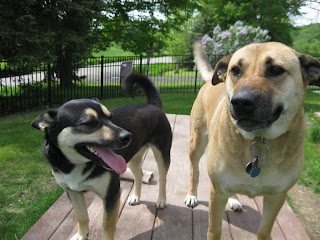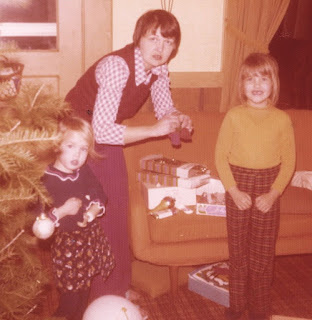Canine behavior conundrum
First there was Opie, who walked off a van in a Kmart parking lot in early January 2015 after living his first seven months in South Carolina. He was timid and subdued at first—totally expected, of course. After he became more at ease and seemed to be settling in, we noticed he kept showing us his teeth. By his posture, it was quite clear that he was not “baring his teeth.” This was . . . different.
It looked more like smiling.
While revealing his teeth, Opie would squint and sometimes slither around like an otter. Well, thanks to the internet, we learned that the “submissive grin” is a thing. Dogs use this expression to communicate to people and other dogs that they are not a threat. OK. I’d never even heard of this before.
Hey, here’s a fun fact. Know what else dogs do to appear non-threatening? Pee. They pee.
I knew that sometimes dogs pee when excited. This wasn't that. In countless interactions with him, Opie would let out a little squirt of pee. It got so routine that he began to associate my reaching for a paper towel with him having peed—so he’d pee.
It happened a lot. We’d attach the leash to his collar, squirt. Come back home after being gone for a while, squirt. Wonder aloud how those shoes got into the living room, squirt. Ask each other, “Did he pee?” —squirt.
I want to be clear, we weren’t punishing him, but he could absolutely sense our frustration.
Our troubleshooting ruled out medical issues and house training deficiencies. Finally, we deduced that the peeing was not a behavioral problem at all: it was communication. This was actually a horrible realization because we feared it might never stop. The peeing was reflexive and instinctive, which you can’t really train out of a dog, and furthermore, it was meant to demonstrate an otherwise desirable state of obedience, of his willingness to please us at all times. To Opie, the peeing signaled compliance and was the right message to send.
The situation felt hopeless. We contemplated making him live mostly outside. We considered doggy diapers.
Instead, I bought Nature’s Miracle by the gallon.
Gradually, the peeing lessened as he grew increasingly at ease in our household and in his place within our “pack.” Eventually he no longer felt the need to constantly signal to us, “I am not a threat!” And while his comfort level is surely the real reason this behavior vanished, I like to imagine him actively working on this, making a concerted effort at self-improvement.
He still shows us his teeth, though.
Opie is extremely intelligent and communicative. He uses body language, facial expressions, and vocalizations quite impressively to get his message across. We see his teeth whenever something is awry:
Sadie got on the couch I don’t think she’s allowed to do that
you guys were gone a really long time I hope that’s OK hope I didn’t do something wrong
did you know we were outside all afternoon I think you forgot us I’m sorry
Dad why aren’t you doing that thing I want you to do come on I’m starting to get frustrated Dad
I want the bed but Sadie’s on the bed Dad please tell Sadie to get off the bed
Speaking of Sadie, she presented her own peeing challenge. The year after Opie arrived, Sadie came to us after living in at least four temporary homes, starting in Texas. These changes in her surroundings happened in rapid succession; she was young, about one or two. By the time we met her, she didn’t know which way was up. She was bumfuzzled.
When we brought her into the house for the first time, she walked around the living room, and every few steps, she’d pee. Unlike Opie, she was obviously marking, but I’d always associated that behavior with walks outside. She just kept doing it! So we ushered her out to the fenced-in yard, where she continued peeing, this time ON the house. She peed a million times out there.
Inside, we regrouped. What the heck. This dog peed on anything that smelled new to her—and everything was new!! I placed a panicked call to Sadie’s foster mother in Texas, who had adored her. She was polite and kind, but she firmly and directly explained that this reaction was not unreasonable or wildly out of bounds for a rescue dog whose world had turned upside down. She urged me to be patient during the transition, reminding me that this was kind of what I signed up for.
Oh. Right.
Texas Dog Mom Extraordinaire was, of course, one hundred percent correct. We restricted Sadie’s world to the mudroom for a few days to get her accustomed to the new smells and sounds, then increased her space ever so gradually over the course of, I don’t actually remember but I want to say, a month? The more time she spent in our space, the more it felt like her space too, so the less she was inclined to mark it.
Half a dozen years later, these guys are a one hundred percent dog rescue success. During those years, they have taught me so much about canine communication and behavior—mainly that I still had a ton to learn! For tips on the transition period for new rescue dogs, see this helpful DogTime article.
For Vermont folks, I recommend both of the rescue organizations that helped our dogs escape kill shelters in the South:
Opie (né Luke) was transported from South Carolina by Passion 4 Paws.
Sadie came from Texas with the help of Good Karma Rescue, but I can't figure out if they're still operating.
If you hate to even think about dogs being in high-kill shelters in the first place, donate here to help get them OUT.





Comments
Post a Comment